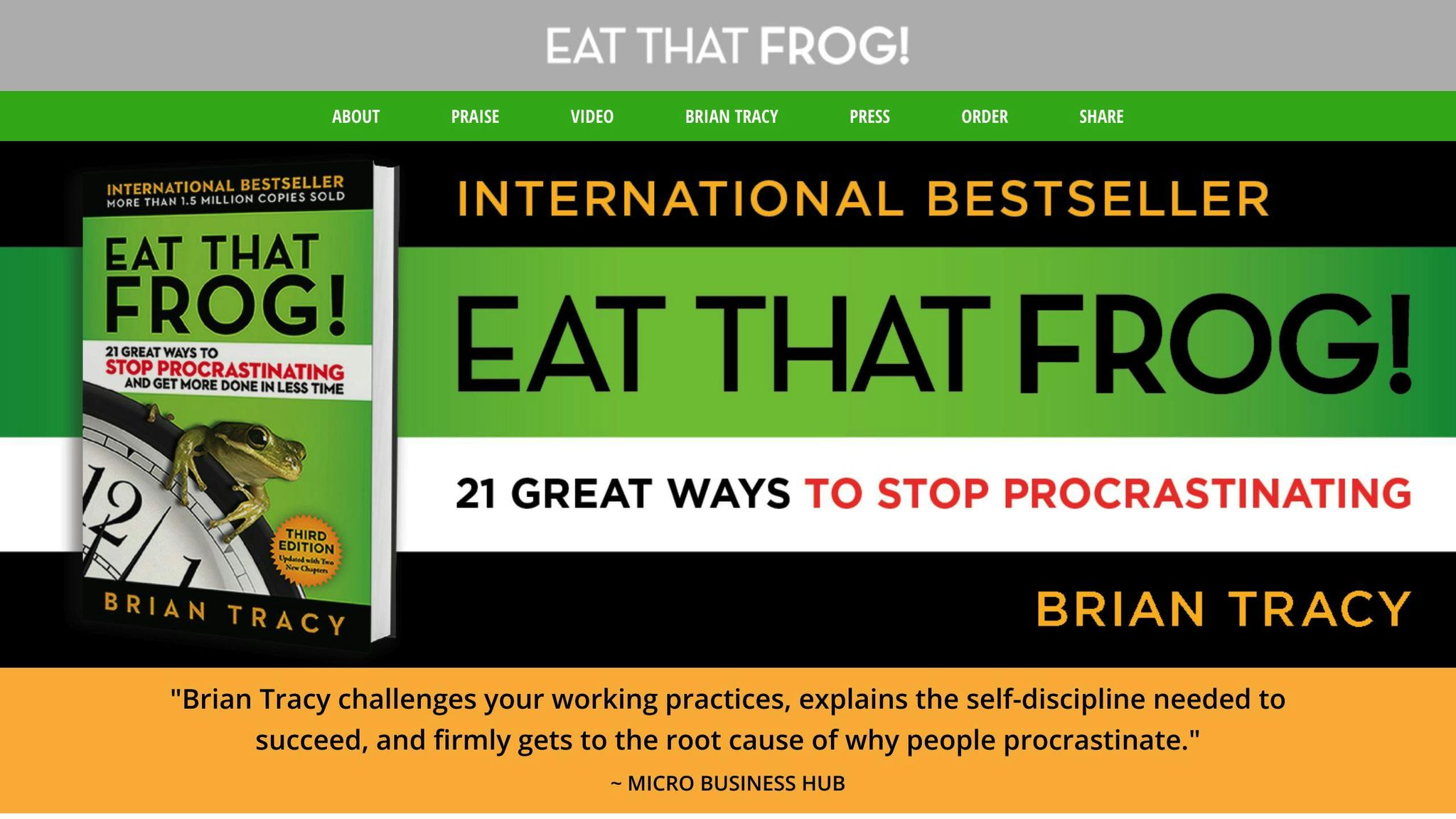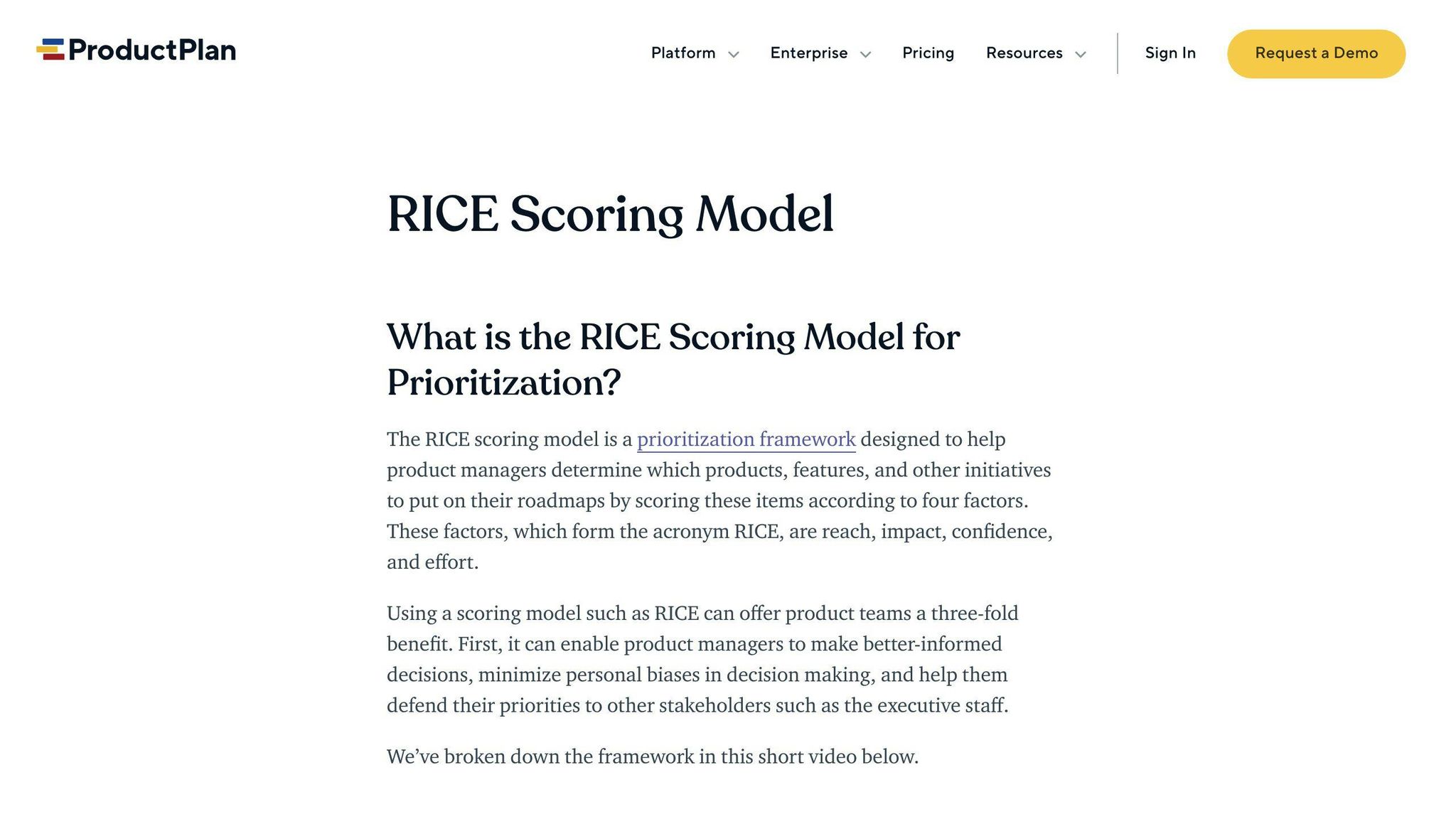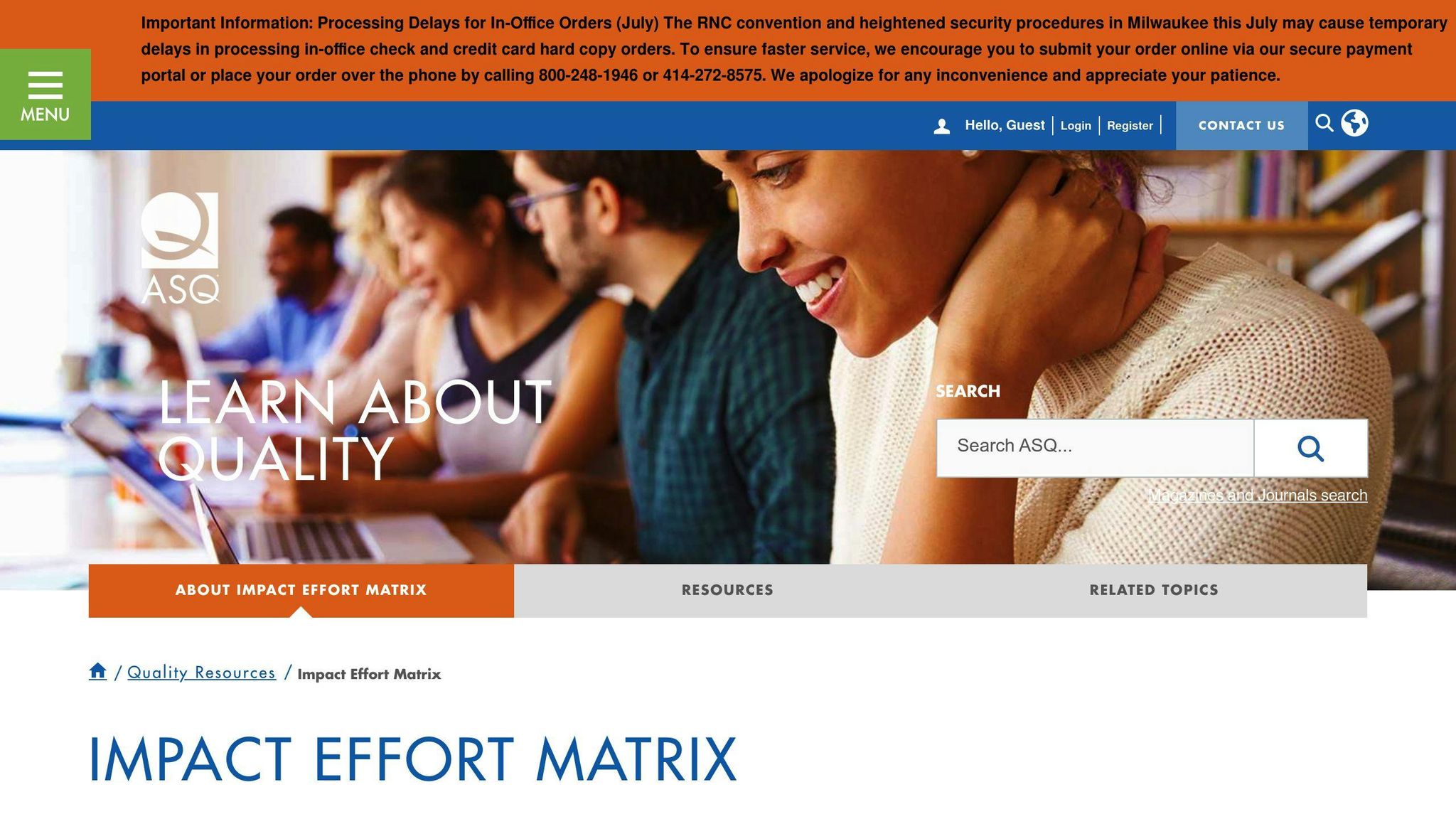10 Task Prioritization Methods for Solopreneurs
As a solopreneur, managing your workload effectively is crucial. Here are 10 proven methods to help you prioritize tasks and boost productivity:
- Eisenhower Matrix
- ABCDE Method
- Pareto Principle (80/20 Rule)
- MoSCoW Method
- Time Blocking
- Ivy Lee Method
- Eat That Frog
- RICE Scoring Model
- Impact-Effort Matrix
- Most Important Task (MIT) Method
Each method offers unique benefits:
| Method | Key Benefit |
|---|---|
| Eisenhower Matrix | Distinguishes urgent from important |
| ABCDE Method | Ranks tasks by importance |
| Pareto Principle | Focuses on high-impact tasks |
| MoSCoW Method | Categorizes tasks by necessity |
| Time Blocking | Improves time management |
| Ivy Lee Method | Simplifies daily planning |
| Eat That Frog | Tackles difficult tasks first |
| RICE Scoring Model | Quantifies task priority |
| Impact-Effort Matrix | Balances effort and results |
| MIT Method | Ensures critical tasks are completed |
By implementing these methods, you'll improve your focus, time management, and overall productivity as a solopreneur.
Related video from YouTube
1. The Eisenhower Matrix

What It Is
The Eisenhower Matrix helps solopreneurs sort tasks based on how urgent and important they are. It splits tasks into four groups:
- Urgent and Important
- Important but Not Urgent
- Urgent but Not Important
- Not Urgent or Important
How to Use It
Here's how to use the Eisenhower Matrix:
- Write down all your tasks
- Decide how urgent and important each task is
- Put each task in the right group
- Do the tasks in group 1 first
- Plan when to do tasks in group 2
- Find someone else to do tasks in group 3
- Try to cut out tasks in group 4
Why It's Helpful
| Benefits | Explanation |
|---|---|
| Better focus | You work on what matters most |
| Save time | You spend less time on unimportant tasks |
| Less stress | You know what to do and when |
| Better planning | You can see what's important for the future |
| Clear priorities | You can tell urgent tasks from important ones |
The Eisenhower Matrix helps solopreneurs manage their time and tasks better. It makes it easier to focus on what's most important for your business.
2. The ABCDE Method
What It Is
The ABCDE Method helps solopreneurs sort tasks by how important they are. Alan Lakein, who knows a lot about getting things done, came up with this idea. You use letters A to E to rank your tasks.
How to Use It
Here's how to use the ABCDE Method:
- Make a list of all your tasks
- Give each task a letter:
- A: Must do
- B: Should do
- C: Nice to do
- D: Can ask someone else to do
- E: Can skip
- Put numbers after each letter (like A1, A2, A3)
- Do all A tasks first, then B tasks, and so on
Why It's Helpful
| Good Thing | What It Means |
|---|---|
| Better Focus | You work on what's most important |
| Clear Order | You know what to do first |
| Use Time Well | You spend time on things that matter |
| Get More Done | You finish big tasks faster |
| Less Worry | Your to-do list feels more under control |
This method is great for solopreneurs who have lots of different jobs to do. It helps you avoid doing easy but less important tasks first. Instead, you focus on what really helps your business grow.
3. The Pareto Principle (80/20 Rule)

What It Is
The Pareto Principle, or 80/20 Rule, says that 80% of your results come from 20% of your work. This means a small number of tasks give you most of your success.
How to Use It
To use the 80/20 Rule:
-
Find your 20% tasks:
- Use tools like the Eisenhower matrix
- Keep track of how you spend your time
- Pick tasks that match your skills and interests
-
Do the 20% tasks first:
- Put these tasks in your schedule first
- Avoid distractions
- Give these tasks enough time
-
Get rid of or give away the 80%:
- Use the 4D method: Delete, Delay, Delegate, or Do
- Ask yourself who, what, when, where, why, how, and how much for each task
-
Check and change:
- Look at how well you're picking tasks
- Update your 20% tasks as your goals change
Why It's Helpful
| Good Thing | What It Means |
|---|---|
| Get more done | Work on tasks that matter most |
| Use time better | Spend less time on small tasks |
| Less worry | Get rid of tasks you don't need to do |
| Make better choices | Know what's really important |
| Grow your business | Focus on what helps you succeed |
4. The MoSCoW Method

What It Is
The MoSCoW method helps solopreneurs sort tasks by how important they are. It splits tasks into four groups:
- Must have: Tasks you need to do
- Should have: Tasks that are important but not critical
- Could have: Tasks you can do if you have time
- Won't have: Tasks you won't do now
How to Use It
To use the MoSCoW method:
- List all your tasks
- Put each task in one of the four groups
- Order tasks in each group by importance
- Write down your list and share it if needed
- Do "Must have" tasks first, then "Should have"
- Check and update your list often
Why It's Helpful
| Good Thing | What It Means |
|---|---|
| Easy to understand | You can quickly see what tasks matter most |
| Better focus | You work on the most important things first |
| Everyone agrees | You and others can agree on what's important |
| Use time well | You spend time on tasks that matter |
| Can change | You can update your list as things change |
This method is great for solopreneurs who have many tasks to do. It helps you focus on what's most important and decide what to do first, what to do later, and what not to do at all.
5. Time Blocking
What It Is
Time blocking helps solopreneurs plan their day by setting aside specific times for tasks. It's like making a schedule for your work day.
How to Use It
To use time blocking:
- Look at all your tasks
- Find out when you work best
- List your tasks and how long they take
- Put tasks in your calendar
- Add some free time between tasks
- Follow your schedule
Why It's Helpful
| Good Thing | What It Means |
|---|---|
| Better focus | You can work on one thing at a time |
| Use time well | You can see how you spend your day |
| Less putting things off | You have set times to do tasks |
| Good work-life balance | You can plan time for yourself too |
| Get more done | You treat your schedule like a boss |
Time blocking helps solopreneurs manage their day better. It lets you focus on one task at a time and plan your work and personal time.
sbb-itb-d6c26b0
6. The Ivy Lee Method

What It Is
The Ivy Lee Method is a simple way to manage tasks. Ivy Lee, who helped people work better, came up with this idea a long time ago. It helps you pick and finish your most important jobs each day.
How to Use It
Here's how to use the Ivy Lee Method:
- At the end of your work day, write down six important tasks for tomorrow.
- Put these tasks in order from most to least important.
- The next day, start with the first task. Focus only on this task until you finish it.
- Move to the next task on your list.
- If you don't finish all tasks, add the leftover ones to a new list of six for the next day.
- Do this every day.
Why It's Helpful
| Good Thing | What It Means |
|---|---|
| Easy to use | You don't need special tools or hard-to-learn systems |
| Better focus | You work on one task at a time, which helps you get more done |
| Clear plan | You know what to do each day, so you don't waste time deciding |
| Can change | You make a new list each day, so you can adjust if things change |
| Shows progress | You can see how well you're managing your tasks |
This method helps solopreneurs get their work done without feeling overwhelmed. It's a good way to stay on top of your tasks and make sure you're doing what's most important each day.
7. Eat That Frog

What It Is
"Eat That Frog" is a way to get things done that Brian Tracy came up with. It says you should do your hardest and most important job first thing in the morning. The "frog" is the job you're most likely to put off because it's hard or not fun. By "eating the frog" early, you make sure you finish your biggest work before other things get in the way.
How to Use It
Here's how to use Eat That Frog:
- Pick your most important job for the day
- Break it into smaller steps if you need to
- Plan to do this job first thing in the morning
- Work only on this job until it's done
- Don't check emails or do other small jobs until you finish the "frog"
Why It's Helpful
| Good Thing | What It Means |
|---|---|
| Get more done | Doing the hardest job first helps you do more all day |
| Less putting things off | Doing hard work right away helps you stop avoiding it |
| Better focus | Spending time on big jobs without stopping helps you think better |
| Feel good about your work | Finishing hard work early makes you feel good for the rest of the day |
| Use time better | Doing big jobs first makes sure they get done |
This method helps solopreneurs get their most important work done without feeling overwhelmed. It's a good way to make sure you're doing what matters most each day.
8. The RICE Scoring Model

What It Is
The RICE Scoring Model helps solopreneurs choose which tasks to do first. It looks at four things:
- Reach: How many people the task will affect
- Impact: How much the task will help (rated 1-5)
- Confidence: How sure you are about your guesses (in %)
- Effort: How much work it will take (in hours or weeks)
How to Use It
To use the RICE model:
- List your tasks
- Score each task on the four RICE things
- Use this math: (Reach x Impact x Confidence) / Effort
- Put tasks in order based on their scores
Here's an example:
| Task | Reach | Impact | Confidence | Effort | RICE Score |
|---|---|---|---|---|---|
| Fix website | 5000 | 3 | 80% | 5 | 2400 |
| New product | 2000 | 4 | 60% | 10 | 480 |
| Better emails | 10000 | 2 | 90% | 3 | 6000 |
In this case, working on emails should come first.
Why It's Helpful
The RICE model is good for solopreneurs because:
- It helps you make choices based on facts
- You can change it to fit your needs
- It makes you use numbers to decide
- It helps you use your time well
- It's easy to explain your choices to others
9. The Impact-Effort Matrix

What It Is
The Impact-Effort Matrix helps solopreneurs choose which tasks to do first. It looks at two things:
- How much a task helps (impact)
- How hard a task is to do (effort)
This method lets you see your tasks on a grid, making it easier to pick the best ones to do.
How to Use It
To make and use an Impact-Effort Matrix:
- Draw a grid with four boxes
- Write down all your tasks
- For each task, think about how much it helps and how hard it is
- Put each task in the right box on the grid
Here's what the grid looks like:
| High Impact | Big Jobs (Do Later) | Quick Wins (Do First) |
|---|---|---|
| Low Impact | Time Wasters (Don't Do) | Easy Jobs (Do If Time) |
| Hard to Do | Easy to Do |
Do "Quick Wins" first, then work on "Big Jobs". Do "Easy Jobs" when you have extra time. Try not to do "Time Wasters".
Why It's Helpful
The Impact-Effort Matrix is good for solopreneurs because:
- It shows tasks clearly on a grid
- It helps you focus on tasks that give the best results
- It mixes quick jobs with bigger projects
- It helps you make better choices about what to do first
- You can use it for different kinds of work
10. The Most Important Task (MIT) Method
What It Is
The Most Important Task (MIT) method helps solopreneurs focus on their top tasks each day. You pick 2-3 key jobs that will help you reach your goals.
How to Use It
To use the MIT method:
- Choose 2-3 main tasks before you start your day
- Pick jobs that help your long-term plans
- Do these tasks when you have the most energy
- Break big tasks into smaller steps if needed
- Use a to-do list or planner to keep track
Why It's Helpful
| Good Things | What They Mean |
|---|---|
| Get more done | You work on tasks that matter most |
| Use time better | You know what to do first |
| Reach goals faster | You make progress on big plans |
| Know what to do | Your day has a clear purpose |
| Feel less stressed | You finish important work |
This method helps solopreneurs work on what's most important each day. It makes sure you're always moving towards your goals, even when other things come up.
Conclusion
Good task planning is key for solopreneurs to do well and get more done. Using the methods in this article can help you work better and focus on what's important. Here's a quick look at why planning tasks is good:
| Good Things | What They Mean |
|---|---|
| Get more done | Work on big tasks first |
| Use time better | Put your effort where it counts |
| Feel less worried | Know what to do each day |
| Make better choices | Pick tasks that help your goals |
| Feel more driven | See your progress |
Remember, there's no perfect way to plan tasks. Try different ways to see what works for you. Keep checking and changing your plans as your business grows.
As Stephen Covey said, "Don't just plan your schedule, schedule your plans." By getting good at planning tasks, you'll be ready to handle the ups and downs of running your own business and reach your big goals.
Things to do now:
- Pick one task planning method to try
- Look at your plans often and make changes
- Ask others what they think of your plans
- Be ready to change when you need to